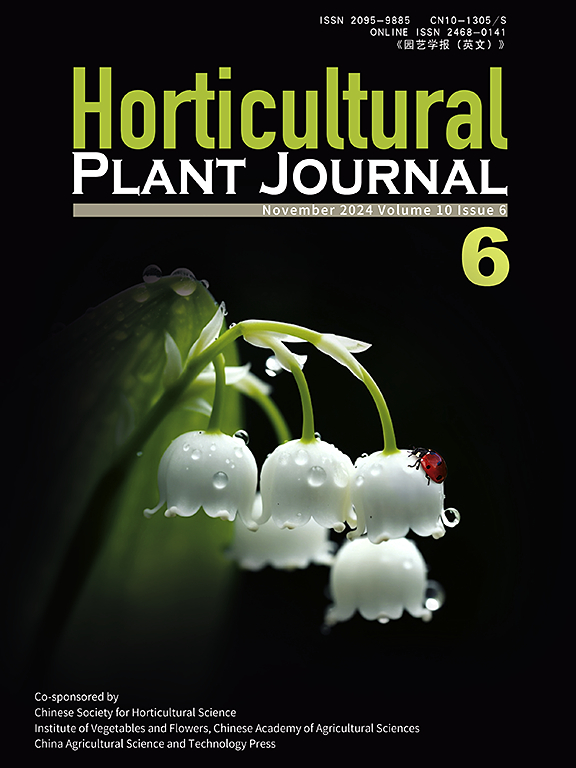解剖分析和双转录组学分析揭示了“亚洲解放Candidatus Liberibacter asiaticus”与柑桔寄主在不同生长期新芽中的相互作用
IF 6.2
1区 农林科学
Q1 HORTICULTURE
引用次数: 0
摘要
黄龙冰(HLB)病原菌亚洲自由候选菌(Candidatus Liberibacter asiaticus, CLas)对柑橘生产构成了严重威胁。新芽在HLB发病系统中起着至关重要的作用,是虫媒获取和传播CLas的关键位点。然而,类与寄主在新梢发育中的相互作用仍然知之甚少。研究了CLas侵染2年生柑橘植株修剪后不同生育期新梢的种群动态、解剖变化和双转录组学特征。CLas种群数量在修剪后2周内迅速增加,在修剪后4周达到高峰,随后在修剪后6 ~ 8周下降。CLas感染抑制了芽的生长,并引起严重的韧皮部塌陷,特别是在8 WAP时。转录组学分析显示,参与转录/翻译、脂质转运和代谢、能量产生和对宿主免疫应答的恢复的CLas基因在4 WAP和8 WAP时高度表达,表明细菌积极适应。在柑橘中,CLas感染主要影响代谢、激素信号转导、细胞壁代谢和转录因子,特别是三螺旋和bHLH家族。柑橘α-亚麻酸、WRKY和MYB转录因子、致病相关蛋白和Ca2+介导的信号相关基因的激活表明,柑橘新芽中存在潜在的防御反应。这些发现提供了CLas及其寄主在柑桔幼芽发育过程中的转录组图谱,为研究CLas与寄主的相互作用和潜在的防御机制提供了新的见解。本文章由计算机程序翻译,如有差异,请以英文原文为准。
Anatomical and dual transcriptomic analysis reveals the interaction of “Candidatus Liberibacter asiaticus” and citrus host in new shoots at different growth stage
“Candidatus Liberibacter asiaticus” (CLas), the causal agent of citrus Huanglongbing (HLB), poses a significant threat to citrus production worldwide. New shoots play a crucial role in the HLB pathosystem, serving as key sites for CLas acquisition and transmission by insect vector. However, CLas-host interactions in newly developing shoots remain poorly understood. This study investigated CLas population dynamic, anatomical change and dual transcriptomic profiles in new shoots at different growth stage after pruning two-years-old CLas-infected citrus plants. CLas population increased rapidly within 2 weeks after pruning (WAP), peaked at 4 WAP and subsequently declined between 6 WAP and 8 WAP. CLas infection inhibited the shoots growth and induced severe phloem collapse, particularly at 8 WAP. Transcriptomic analyses revealed that CLas genes involved in transcription/translation, lipid transport and metabolism, energy production, and resilience to host immune response were highly expressed at 4 WAP and 8 WAP, indicating active bacterial adaptation. In citrus, CLas infection primary affected metabolism, hormone signal transduction, cell wall metabolism, and transcription factors, particularly trihelix and bHLH families. The activation of citrus genes related to α-linolenic acid, WRKY and MYB transcription factors, pathogenesis-related proteins, and Ca2+ -mediated signaling suggested potential defense response against in new shoots. These finding provide a comprehensive transcriptome landscape of CLas and its host in developing shoots, offering new insights into CLas-host interactions and potential defense mechanisms in citrus.
求助全文
通过发布文献求助,成功后即可免费获取论文全文。
去求助
来源期刊

Horticultural Plant Journal
Environmental Science-Ecology
CiteScore
9.60
自引率
14.00%
发文量
293
审稿时长
33 weeks
期刊介绍:
Horticultural Plant Journal (HPJ) is an OPEN ACCESS international journal. HPJ publishes research related to all horticultural plants, including fruits, vegetables, ornamental plants, tea plants, and medicinal plants, etc. The journal covers all aspects of horticultural crop sciences, including germplasm resources, genetics and breeding, tillage and cultivation, physiology and biochemistry, ecology, genomics, biotechnology, plant protection, postharvest processing, etc. Article types include Original research papers, Reviews, and Short communications.
 求助内容:
求助内容: 应助结果提醒方式:
应助结果提醒方式:


